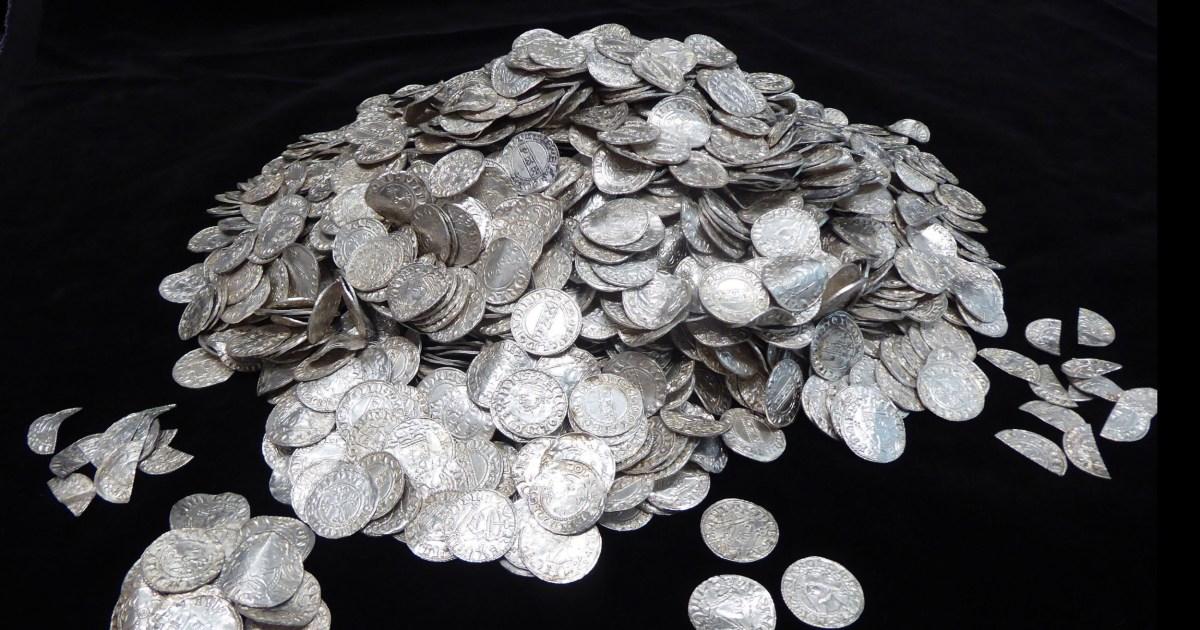The silver coins were found in January 2019 and it has taken five years for the hunters to receive their money (Picture: PA)
A team of seven treasure hunters who uncovered a hoard worth a record £4.3 million are now a lot richer.
The rare find of silver coins that dates back 1,000 years was found in the Chew Valley area of Somerset in January 2019.
The bulk of these were found by Adam Staples, 48 and his girlfriend at the time, Lisa Grace, and five friends.
But it has taken them five years to receive a penny of it through.
Adam, an auctioneer from Derby, said: ‘It’s like winning the lottery but then you can’t cash the ticket for five years.
‘Coming to the British Museum a few days after we found the hoard, when they opened the front gates and we drove through crowds with a few million pounds worth of coins in the back of the car, was a surreal experience.
‘And then it was Covid and five years of silence until we got to this point.
‘It’s frustrating, but it’s still winning the lottery, so you feel like you can’t complain.
Lisa Grace and Adam Staples are just two of the people who found the treasure (Picture: PA)
The coins are from the reigns of Harold II (right) and William the Conqueror (left) (Picture: PA)
The coins have been unveiled at The British Museum (Picture: PA)
‘We received the money a few weeks ago – I’ve bought a house and can now live mortgage-free.’
Half of the money will go to the landowner and the rest has been split between Adam, Lisa and the friends meaning they get around £300,000 each.
Adam has not given up on hunting for more treasure though despite the win and went on his last hunt just on Sunday.
The hoard will go on display at the British Museum in London next month.
It will later be exhibited in museums across the UK, before finding a permanent home at the Museum of Somerset.
The payout took five years because the hoard was reported under the Treasure Act 1996, involving a lengthy process.
It was found in January 2019 and declared as treasure in 2020. The valuation process for the hoard involved five separate assessments, beginning in early 2022 and ending in late 2023.
This coin is from the time of Edward the Confessor (1042-66) (Picture: PA)
The hoard show signs of being illicitly tampered with because it has mixed designs on either side.
This is evidence that the person striking the coins was avoiding paying a fee to obtain an up-to-date design.
Gareth Williams, a curator at the British Museum, said the making of false coinage risked a severe penalty – having a hand cut off – at the time.
More Trending
‘We can see from these coins that that wasn’t a deterrent,’ he said.
Evidence showed that whoever buried the hoard was ‘involved in some way in the Battle of Hastings’, he said.
This person ‘may or not’ have come to an unpleasant end, Gareth added.
It is thought the coins at the time would have been owned by somebody wealthy who may have buried them for safekeeping.
Get in touch with our news team by emailing us at webnews@metro.co.uk.
For more stories like this, check our news page.
MORE : Everyone’s confused by £350,000 road markings outside school that look like Twister
Get your need-to-know
latest news, feel-good stories, analysis and more
This site is protected by reCAPTCHA and the Google Privacy Policy and Terms of Service apply.
var notifyQ = function () {
var i = 0,
l = awaitingReady.length;
for (i = 0; i
Checkout latest world news below links :
World News || Latest News || U.S. News
The post Seven treasure hunters find 1,000-year-old pennies and sell them for £4,300,000 appeared first on WorldNewsEra.

